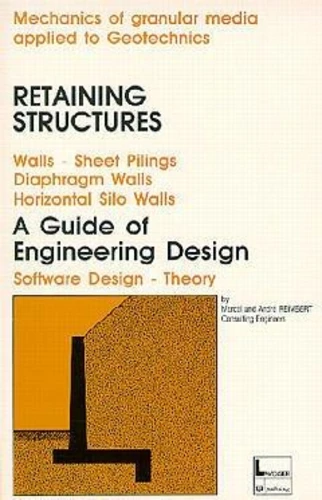Retaining structures. Walls-sheet pilings, diaphragm walls, horizontal silo walls, a guide of engineering design, software design and new theory
Par :Formats :
- Paiement en ligne :
- Livraison à domicile ou en point Mondial Relay indisponible
- Retrait Click and Collect en magasin gratuit
- Réservation en ligne avec paiement en magasin :
- Indisponible pour réserver et payer en magasin
- Nombre de pages176
- PrésentationRelié
- Poids0.32 kg
- Dimensions15,5 cm × 24,0 cm × 0,1 cm
- ISBN2-85206-549-5
- EAN9782852065499
- Date de parution01/06/1994
- ÉditeurTec & Doc (editions)
Résumé
A guide for the calculation of the maximum active pressures and minimum passive pressures, in the cases of backing materials with a horizontal or inclined surface, and vertical or inclined walls, in the exact definited ' at rest ' state. Active pressures due to the local or enly distributed loads acting on the backing. Rotary or translatory passive pressures of the screen, in the elastoplastic phase, with calculation of the displacements of this screen.
Safety coefficient. Theory of the wall/backing equilibrium based on COULOMB's rupture thrust wedge. Objection to RANKINE's theory. Transitional active pressure and passive pressure. Determination of the four friction angles which characterize a pulverulent material. Reminder of the research and control experiments on the proposed formular. A software design for the calculation of active and passive pressures.
Examples. Realizations. Precautions in the design and carrying out.
Safety coefficient. Theory of the wall/backing equilibrium based on COULOMB's rupture thrust wedge. Objection to RANKINE's theory. Transitional active pressure and passive pressure. Determination of the four friction angles which characterize a pulverulent material. Reminder of the research and control experiments on the proposed formular. A software design for the calculation of active and passive pressures.
Examples. Realizations. Precautions in the design and carrying out.
A guide for the calculation of the maximum active pressures and minimum passive pressures, in the cases of backing materials with a horizontal or inclined surface, and vertical or inclined walls, in the exact definited ' at rest ' state. Active pressures due to the local or enly distributed loads acting on the backing. Rotary or translatory passive pressures of the screen, in the elastoplastic phase, with calculation of the displacements of this screen.
Safety coefficient. Theory of the wall/backing equilibrium based on COULOMB's rupture thrust wedge. Objection to RANKINE's theory. Transitional active pressure and passive pressure. Determination of the four friction angles which characterize a pulverulent material. Reminder of the research and control experiments on the proposed formular. A software design for the calculation of active and passive pressures.
Examples. Realizations. Precautions in the design and carrying out.
Safety coefficient. Theory of the wall/backing equilibrium based on COULOMB's rupture thrust wedge. Objection to RANKINE's theory. Transitional active pressure and passive pressure. Determination of the four friction angles which characterize a pulverulent material. Reminder of the research and control experiments on the proposed formular. A software design for the calculation of active and passive pressures.
Examples. Realizations. Precautions in the design and carrying out.

